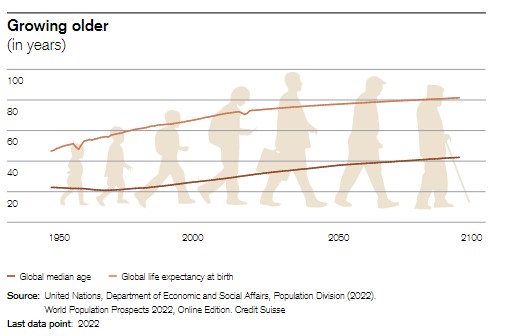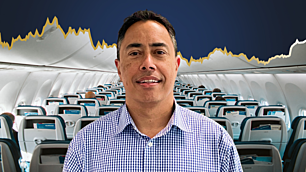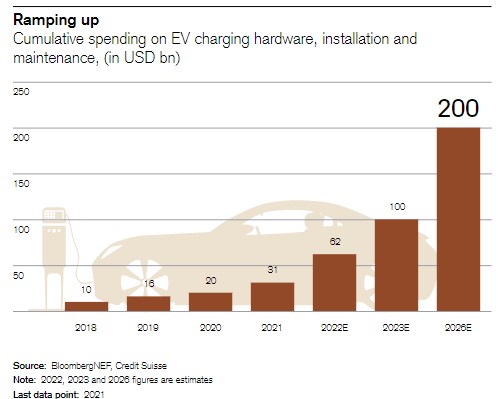10 ASX-listed stocks to access 3 of this decade's megatrends
There’s no question the world’s population is living through BIG changes. We often describe the forces behind these as mega trends or super trends, aka powerful structural forces that will change the way we live, work and interact. The megatrend you’ve probably heard the most about is decarbonisation, but it’s far from the only one changing our world.
Credit Suisse recently released a report titled Supertrends 2023. Investing reimagined. covering the six super-trends it has identified. These included climate change (or decarbonisation), technology, infrastructure, silver economy, anxious societies, and millennials’ values. It’s worth noting that super-trends do interact with and influence each other.
In this wire, I’ll look at 3 of the less discussed, or ‘forgotten’ trends and some of the companies accessing these trends. These include:
- The silver economy
- Anxious societies
- Infrastructure
Please note: any companies referenced in this article are to help inspire your research into these areas rather than a recommendation to buy.
The silver economy
Often when we think of an aging population, we think of the extraordinary shift of the boomer generation from working age to retirement, but the question of increasing aging population is a bigger story than simply that.
The portion of the global population aged over 65 years is expected to jump from 780 million today to 2.5bn by 2100.

According to Lorenzo Biasio, Senior Equity Analyst – Healthcare and Samuel Traub, Equity Research Analyst – Banks and Insurance, there will be enormous demand (and opportunities) for companies in healthcare, insurance, discretionary consumer goods and services, and property markets.
To put it in perspective, today’s retirees are typically fitter and healthier than previous generations. They have accumulated wealth from their own working life, and many also have inheritances from their parents. They also are more likely to have cash available for discretionary needs ranging from travel to luxury goods, healthcare needs from vision and hearing to specific age concerns. Their accommodation needs shift as they age, but they need flexibility to deal with it and remain in their communities – this is also a massive growth area, there is simply not enough aged care to accommodate the population.
So where should investors be looking according to Biasio and Traub?
- Biopharmaceutical, medical technology and life sciences companies that address conditions affecting the elderly.
- Health and life insurance, private wealth advisors and asset managers.
- Discretionary needs across areas from tourism, beauty and luxury goods.
- Aged care accommodation.
Examples of ASX-listed companies in these areas:
-
Cochlear (ASX: COH)
It’s worth noting that a range of studies have suggested correlation between hearing loss and dementia, with the suggestion that managing hearing loss may help stave off dementia. Ongoing research into this could mean a massive step up in growth for companies like Cochlear.

-
Estia Health (ASX: EHE)
One of Australia’s largest aged care providers caring for over 8000 residents across more than 70 homes in Australia.

-
Flight Centre (ASX: FLT)
One of the most shorted stocks this year, the travel agent is still benefitting from pent-up demand post-covid. It may also benefit from discretionary spending from older people.

-
Medibank (ASX: MPL)
Health insurers are likely to benefit from an audience considering private cover to support potential aged-related health concerns. Despite the hit from the cyber-attack last year, Medibank is one of the insurers that could benefit.
.jpg)
Anxious societies
From a shorter-term perspective, there’s a lot for people to be anxious about. We’re still coming out of a global pandemic, there’s slowing growth and rising inflation, we have energy challenges and alongside this, there’s still global conflict, with the Russian invasion of Ukraine a prominent case in point.
These are just part of a bigger trend, however.
The global population hit 8 billion in November last year. It’s expected to hit over 10 billion in the mid-2080s. This gives rise to a range of problems that we’re already starting to feel, such as feeding a population that size or housing.
Technology is also a contributor towards the concept of anxious societies.
There’s the balance between it improving our lives compared to isolating us from human contact. There’s also managing the use of technology to commit crimes, such as cyberattacks. As a global population, we are forced to become more and more concerned about managing our digital safety. The annual cost of cybercrime is estimated to be US$8 tr in 2023 and US$10.5tr by 2025 according to Cybersecurity Ventures.
Cybersecurity is also a government problem.
After all, a measured attack can take out major infrastructure. The US Department of Energy noted that physical and computerised attacks on power grids increased by a record 74% YOY in 2022.

So where should investors be looking according to Reto Hess, Head of Single Security Research Equity, Industrials?
- Companies offering solutions that lower the cost of basic needs like food, housing, healthcare, energy and education.
- Companies that offer products to make workflow more flexible, efficient or productive – or offer training and education.
- Companies that offer protection from violence, cybercrime or the ability to monitor, detect and contain pathogens.
Examples of ASX-listed companies in these areas:
-
Simonds Group (ASX: SIO)
Simonds Group partnered with Contour 3D in 2022 to develop 3D printed homes. This could be a potential cost-efficient solution to housing problems. It’s worth noting it is a challenging environment for housing companies with supply-demand dynamics in play, but certainly the movement towards 3D printing is worth watching. Read more.
-
Wisetech (ASX: WTC)
The Australian logistics software and process solutions company is one of many examples of offering more efficient workflows management.
Morningstar and Morgan Stanley both recently cited it as having strong future prospects.

.png)
-
Whitehawk (ASX: WHK)
Whitehawk is known for offering online global platforms and software for end-to-end risk identification and mitigation – they are the world’s first cybersecurity exchange. It has won a key US federal government contract worth $5.9m back in 2020.
Infrastructure
While the green transition is one of the big themes in changing infrastructure, it is far from the only one. We are seeing rapid advances in technology and communications, changing supply chains and changing approaches to transport. All at a point that older infrastructure might be aging out or in need of upgrades.
Estimates range for the green transition, but a report by McKinsey suggests that US$9.2 tr more in spend is required to reach net-zero by 2050. The required infrastructure is vast. There’s development of renewable and alternative sources of energy like solar, hydro, wind, green hydrogen and even uranium, let alone transforming power grids to support it. There’s also green transport within that – for example, encouraging greater use and development of rail networks over trucking.
The transition to electric vehicles (EVs) and the need for infrastructure in the form of charging stations is also another significant component.

EVs also change what’s required of existing infrastructure and how we might use it. Toll roads might change in how they look and operate for example, in the years to come.
Another rapid change influencing infrastructure is in terms of wireless networks. We are still in the rollout phase of 5G networks with companies looking at ways to capitalise off this with more advanced infrastructure. What will 6G look like when that arrives? What spend will come with that? In the interim though, infrastructure supporting 5G remains an opportunity and companies accessing this infrastructure might be gamechangers.
So where should investors be looking according to Pedro Iglesias De La Vega, Equity Research Analyst, Materials?
- The liquified natural gas (LNG) infrastructure build out is a continued opportunity.
- Companies involved in infrastructure development for smart and connected cities with downstream applications close to end users.
- Companies involved in the roll out of EV charging stations, along with transportation infrastructure operators.
Examples of ASX-listed companies in these areas:
-
Origin Energy (ASX: ORG)
Origin is one of Australia's leading energy companies, exploring, generating and delivering energy to over 4 million customer accounts.
.jpg)
-
Telstra (ASX: TLS)
The telecommunications company is also Australia’s largest internet of things (IoT) network, crucial to creating smart and connected cities and supporting end user applications.

-
Ampol (ASX: ALD)
Ampol is one of Australia’s largest transport energy distributors. It formed an agreement with the Australian Renewable Energy Agency last year for an initial roll out of EV charging stations to approximately 120 sites by October 2023. Read more.
To invest or not to invest in super-trends?
We often talk about following trends as being a risky approach. Super-trends are a bit different in that they are long term forces, with government backing behind them. That said, you don't always know which companies will be the winners and losers in the battle for dominance. Looking for established players with exposure can be a good way of accessing super-trends.
Which super-trends are you following in your portfolio? Let us know in the comments.
3 topics
10 stocks mentioned

